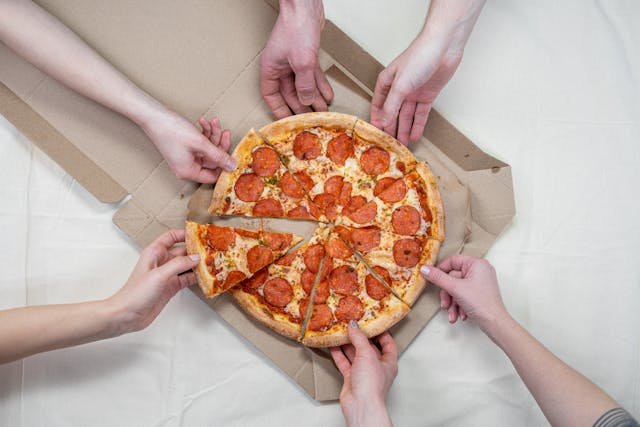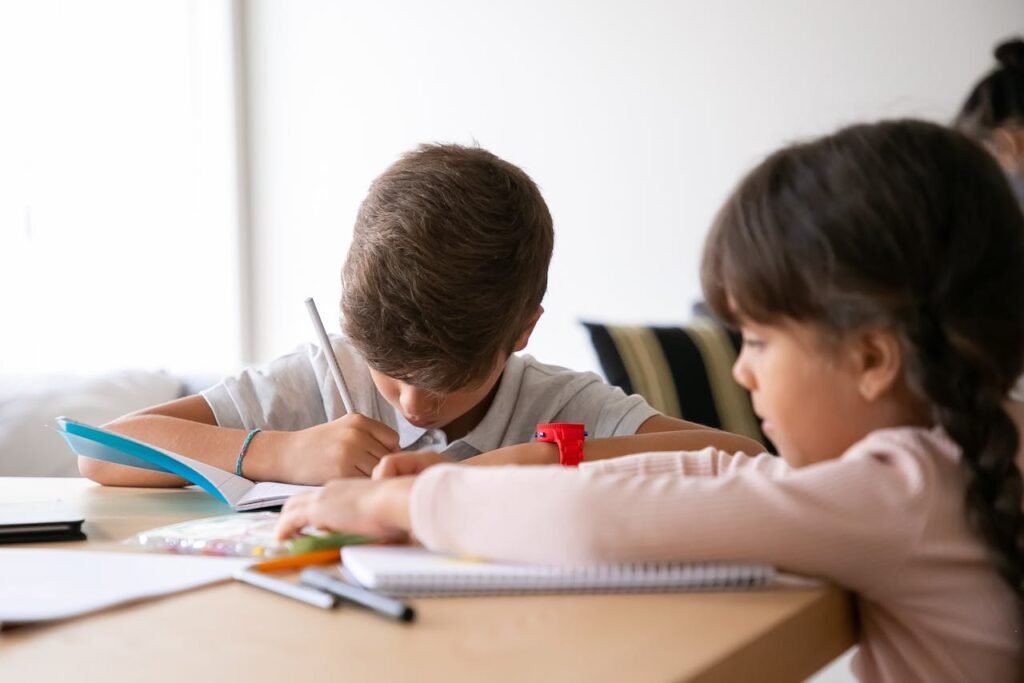Decimals and fractions are like two different ways to tell the same story. One uses a dot and numbers. The other uses a top number and a bottom number with a line in between. But both are just trying to explain how much of something you have—maybe a piece of a pizza, part of a cookie, or time left on a game timer.
Still, many kids (and even grown-ups) wonder: Which is easier? When should I use a decimal? When should I use a fraction? These are really good questions. And the answer is—it depends.
In this guide, we’re going to walk through the world of decimals and fractions, side by side. We’ll explain when each one is better, why both are useful, and how to pick the right one at the right time. And we’ll do it in the simplest way possible, like a calm, friendly teacher showing you how it all works.
What Are Decimals and Fractions, Really?
Imagine you’re holding a chocolate bar. You break it into 10 equal pieces. You eat 3 of those pieces.
You could say:
“I ate 3 out of 10 pieces.” That’s a fraction: 3⁄10
Or you could say:
“I ate 0.3 of the chocolate bar.” That’s a decimal.
Here’s the big secret: They mean the exact same thing.
3⁄10 = 0.3
One uses a line. The other uses a dot. But both tell you that you ate 3 pieces out of 10.
This is the first thing we teach kids at Debsie—decimals and fractions are not enemies. They are two friends who just like dressing differently. Once you understand this, everything else gets easier.
Fractions Feel Like Slices
When you hear the word fraction, think of a pizza. A cake. A pie. Something round that gets cut into equal parts.
Fractions are really good at showing pieces of a whole, especially when things are split into easy numbers—like halves, thirds, or fourths.
If you have half of a sandwich, that’s ½. If you share a candy bar with two friends, each person gets ⅓.
Fractions are helpful when we want to see how things are split up. That’s why teachers often use circles, bars, or paper folds when first teaching them.
And that’s why fractions are often easier when you’re dealing with parts that don’t break down so neatly—like ⅓, ⅕, or ⅛. These are harder to write as decimals, but simple as fractions.
Decimals Feel Like Measurements
Now think about a ruler. Or a measuring cup. Or money.
You don’t say, “I have one-fifth of a dollar.” You say, “I have $0.20.”
You don’t say, “My juice is at seven-eighths.” You say, “It’s 0.875 full.”
Decimals are great for measuring. They’re used everywhere—on clocks, thermometers, weight scales, and in shopping. Why? Because decimals are easier for calculators and computers to work with. They fit better with base 10, the system we already use for counting.
So, while fractions are great for splitting up objects, decimals are perfect when you want to measure, compare, or calculate with precision.
At Debsie, we help children understand that both tools are useful—but each one shines in its own way.
Which Is Easier—Decimals or Fractions?

Some kids find decimals easier. Others feel more comfortable with fractions. But here’s the truth: it depends on what you’re doing.
If you’re baking a cake and the recipe says “⅔ cup of milk,” fractions make sense. You might even use a measuring cup that shows that exact amount. But if you’re checking the price of a toy—like $12.99—you’re dealing with decimals. And that’s where decimals are easier.
The trick is learning when to use each one. And that’s something we love teaching at Debsie—because once kids learn to choose the right form, they stop feeling stuck.
Let’s look at a few clear examples.
Fractions Are Easier for Sharing and Splitting
Let’s say you have 3 friends and 1 big cookie. How do you share it fairly?
You probably wouldn’t say, “Each of you gets 0.3333333 of the cookie.” That’s hard to picture.
You’d say, “We’ll each take ⅓.” That makes more sense. It’s simple. It’s fair. And it’s easy to show or draw.
So when you’re talking about sharing, dividing, or slicing things—fractions feel more natural. That’s why we use them in word problems about pizza, pie, and playtime.
Fractions also work better when numbers don’t break evenly into ten. Imagine trying to write ⅛ as a decimal. It’s 0.125. That’s hard for most kids to remember. But ⅛? Much easier to use and understand.
That’s why we say: if you’re cutting something up, or dividing something between people, fractions are your friend.
Decimals Are Easier for Measuring, Comparing, and Calculating
Now imagine you’re at the store. You want to buy 2.5 kilograms of rice. That’s a decimal. You won’t find a bag labeled “2 ½ kg,” even though that’s the same thing.
That’s because decimals are smoother when working with money, time, weight, or distance.
Want to know if 0.75 is more than 0.65? Easy—just compare the numbers, like regular math.
Want to know if ¾ is more than ⅔? Now it gets trickier. You need to make the denominators match or change them to decimals. That takes a few steps.
So when you want to compare things quickly, do calculations, or work with measuring tools, decimals win. They fit better with our number system and they’re easier to line up in columns when you’re adding or subtracting.
At Debsie, we show children how to switch back and forth between decimals and fractions—so they always feel in control, no matter which form they’re working with.
How to Switch Between Decimals and Fractions
Let’s start with a common example: ½.
How do we turn that into a decimal?
Easy—just divide the top number (1) by the bottom number (2).
So:
1 ÷ 2 = 0.5
That’s it. That’s the decimal.
You can try more:
¼ = 1 ÷ 4 = 0.25
¾ = 3 ÷ 4 = 0.75
⅕ = 1 ÷ 5 = 0.2
This is something we teach kids to do slowly at first, often using pictures too. They see the shape, they see the parts, and then they press the buttons on a calculator. This makes the connection between the shape (fraction) and the number (decimal) feel real.
At Debsie, we never skip straight to the decimal. We always start by helping the child see the fraction first. Once they understand what the piece means, the decimal feels natural.
Turning a Decimal Into a Fraction (Also Simple!)
Now let’s go the other way.
Say you see the decimal 0.5. What’s the fraction?
You ask: “How many places are after the decimal point?”
In 0.5, there’s one number after the dot. That means it’s out of 10. So:
0.5 = 5⁄10
Now simplify it if you can. 5⁄10 becomes ½.
What about 0.25? That’s two digits after the dot, so it’s out of 100:
0.25 = 25⁄100, which simplifies to ¼.
We guide kids through this process using real-world examples—like money. If they understand that $0.25 is 25 cents, and 25 cents is one quarter, then they know 0.25 = ¼.
We make it feel practical. Because when something feels useful, kids want to learn it.
Why Learning to Switch Helps So Much
When a child can move between decimals and fractions easily, they stop being afraid of word problems. They stop getting stuck when a question uses one form and their brain is thinking in the other.
Let’s say a child knows that 0.75 = ¾.
Now they can add ¼ + 0.75 by switching the fraction into a decimal. Or they can turn the decimal into a fraction. Either way, they stay in control.
It’s like speaking two languages fluently. You’re not guessing. You’re choosing. That’s what true understanding feels like.
And at Debsie, that’s always the goal—not just solving a problem, but knowing why it works and how to switch it when you need to.
Where Do We See Decimals and Fractions in Real Life?

Think about pizza night. You cut a pizza into 8 slices, and your friend takes 3 slices. How much did they eat?
They ate 3⁄8 of the pizza.
Or maybe you bake a cake and cut it into 6 equal pieces. You eat 2. That’s 2⁄6, which you can simplify to ⅓. You’ve just done fraction math—without even knowing it.
This is why we say fractions live in the kitchen, on your plate, and at birthday parties.
Fractions also show up when kids share toys, time, or even screen time. If there’s one hour left and two siblings need equal turns, each one gets ½ hour. If there are four friends and one hour to play, they each get ¼ hour.
Sharing fairly? That’s a fraction.
At Debsie, we make sure our fraction lessons feel like everyday life. We don’t just give worksheets. We talk about snacks, stories, games, and situations children already understand. That’s how the learning sticks.
Decimals Are in Money, Measurements, and Machines
Now let’s talk about decimals.
You go to the store. You buy candy for $1.50. That’s a decimal.
You weigh fruit, and it says 2.4 kilograms. That’s a decimal.
You fill a measuring cup with 0.75 cups of milk. Another decimal.
Decimals are everywhere in measuring, shopping, and using tools. When you check the weather (24.5°C), or scroll through a sale (now 30.99% off!), or even type on a calculator, you’re using decimals without even thinking about it.
That’s why we say decimals are the math of the real world. They show up when we measure things, compare prices, or track progress.
At Debsie, we don’t just teach decimals using number lines. We use stories, role-playing, pretend shopping, pretend cooking—even building games. That way, children feel like they already know how to use decimals because they’ve seen them in real life.
And once they feel that familiarity, the fear goes away.
When Kids See Math in Life, They Learn Without Trying
The best kind of learning doesn’t always feel like learning.
When a child says, “Oh! I know this! That’s like when we cut the cake,” they’re making a powerful connection. That moment is more important than memorizing steps.
It’s what we aim for in every Debsie class—real understanding that doesn’t disappear after the test.
By showing kids how fractions and decimals live around them, we help them think more clearly, make better decisions, and enjoy the process of learning math—not just doing it.
Why Kids Struggle With Decimals and Fractions—And How to Fix It

If your child gets stuck, frustrated, or even upset when working with decimals or fractions—you’re not alone. These topics are some of the most confusing in early math. But the problem isn’t your child’s ability. And it’s not that the topic is “too hard.” The real reason most kids struggle is because decimals and fractions are often taught with numbers first, instead of meaning. Kids are asked to follow steps before they understand why the steps work. At Debsie, we believe the fix is simple: show them what it means, make it visual, and connect it to real life. That’s when the lightbulb turns on—and math becomes clear again.
It’s Not the Math. It’s the Way It’s Taught.
If your child says, “I hate fractions,” or “Decimals are too hard,” it’s usually not the math they’re scared of—it’s the confusion. Many lessons move too fast. They skip the visual part. They go straight to numbers and rules before a child even understands what the numbers mean.
This is why so many children get stuck. They try to memorize steps instead of truly understanding the idea. And when the problem looks slightly different? They freeze.
At Debsie, we fix this by going back to the beginning. We start with what the child can see. Then we show them how it connects to numbers. We always build from real to abstract—not the other way around.
When kids are allowed to slow down, ask questions, and connect the math to their own life, the fear goes away. And the learning sticks.
Fractions Can Feel Like a Puzzle With Missing Pieces
A lot of kids struggle with fractions because the pieces don’t feel fair. Why is ⅓ bigger than ¼ if 4 is bigger than 3? It doesn’t seem to make sense—until you see it drawn out.
That’s why we use pie models, paper folding, and real food in our Debsie lessons. When a child draws two rectangles and shades different amounts, they stop guessing and start seeing the truth. We hear kids say, “Ohhh! Now I get it!” all the time.
If a child is struggling with comparing fractions or adding them, don’t give them a trick. Give them time. Give them pictures. Let them see it.
And when they see it—they’ll remember it.
Decimals Look Scary Because They’re Long
Decimals often have more digits. More dots. More numbers. That makes them look scarier than they are.
Children often panic when they see 0.375 or 2.145—but these are just numbers between numbers. We teach kids to look at them one part at a time.
We say, “Don’t look at the whole number. Just look at the tenths first.” Then we break it down. When they understand that 0.5 means halfway, and 0.25 means a quarter, the fear melts away.
And once they realize that 0.75 is just ¾, suddenly it’s not a scary decimal—it’s a friendly fraction in disguise.
How Parents Can Help—Even If You’re Not “Good at Math”

Many parents feel nervous when their child struggles with math—especially with topics like decimals and fractions. You might think, “I wasn’t good at this in school… how can I help now?” But here’s the truth: you don’t need to be a math expert to make a big difference. What your child needs most is your support, your calm, and your curiosity. When you show interest, ask questions, and make math part of everyday life, you’re already doing something powerful. Even the smallest moments—like cutting a sandwich or shopping at the store—can turn into math magic. And it all starts with showing up, just as you are.
Make It Part of Everyday Life
You don’t need to teach a full lesson to help your child understand decimals and fractions. Just talk about them when they naturally show up.
Pour juice into a measuring cup and say, “Look, this is ½ cup.”
Cut a sandwich and ask, “Do you want half or a quarter?”
At the store, talk about prices: “This costs $1.50. That’s one dollar and fifty cents—like 1 and a half dollars.”
When kids hear these words in real-life moments, they learn without even realizing it. It becomes normal. And that’s what builds real understanding—not drills, but conversations.
Use Visuals and Objects
Children learn with their eyes and hands, not just their ears. So if your child is struggling, don’t start with paper—start with things you can touch.
Use apples, chocolate bars, blocks, or even cut-up paper to show what ⅓ or ¾ looks like. Compare sizes. Stack blocks. Fold napkins. Anything that turns numbers into shapes helps your child build mental pictures.
This is how kids go from memorizing to understanding. It’s how they build math confidence that lasts.
Celebrate Effort, Not Just the Answer
If your child is trying hard to understand, that’s already a win. At Debsie, we celebrate every step—even if the final answer is wrong. Why? Because we’re building a learner, not just a score.
At home, do the same. If your child says, “I got 3⁄4, but I’m not sure,” say, “That’s a great start! Let’s check it together.” Make it a team effort, not a test.
When kids feel safe to make mistakes, they learn faster, think deeper, and grow stronger.
How Debsie Helps Kids Master Decimals and Fractions with Confidence

At Debsie, we know that the best way to teach a new concept is to connect it to something the child already understands. That’s why we begin every decimals and fractions lesson with real-life examples. Food, money, games, time—these are things every child knows. So we use them to gently open the door to math.
When a child hears “¾ of a pizza” or “$0.50 from a dollar,” they lean in. They understand the story. And once they see it, they’re ready to learn the math behind it.
We don’t rush into tricky terms or fast rules. We take it step by step, using visuals, hands-on activities, and clear explanations that make everything feel simple.
Personalized Teaching for Every Learning Style
Every child is different. Some are visual learners. Some need to move, talk, or draw. Some are nervous around numbers, and others are eager to dive in. Our Debsie teachers are trained to spot those differences and adapt their teaching style to fit each student.
If a child needs more time to grasp fractions, we give it. If they’re racing ahead with decimals, we challenge them. And through it all, we keep the learning fun, kind, and encouraging.
We also help children switch between fractions and decimals with ease, so they never feel “stuck” when a question shows up in a different form. We want them to feel confident, flexible, and in control.
That’s what real learning feels like.
Learning That Feels Fun, But Goes Deep
At Debsie, we don’t believe in boring worksheets or one-size-fits-all lessons. We believe in joyful learning that goes deep.
Our courses are full of fun problems, interactive tools, and relatable stories that make math feel like an adventure. Kids aren’t just memorizing steps—they’re building real understanding they’ll use forever.
And because we teach all ages—from 5 to 18—we support your child at every stage of their math journey, from their very first fraction to their most advanced decimal calculations.
Final Thoughts: Your Child Can Master Decimals and Fractions
Decimals and fractions may look different, but they’re both ways of saying the same thing—how much of something you have. Once your child learns to see the math, not just the numbers, everything becomes easier.
They start noticing fractions in cake slices, decimals on price tags, and math all around them. That’s when learning stops feeling hard—and starts feeling like life.
At Debsie, we believe that every child can understand math deeply, no matter where they start. With kind teachers, simple visuals, and real-life examples, we help turn confusion into confidence.
Because when math makes sense, everything else becomes possible.
Read Next:
